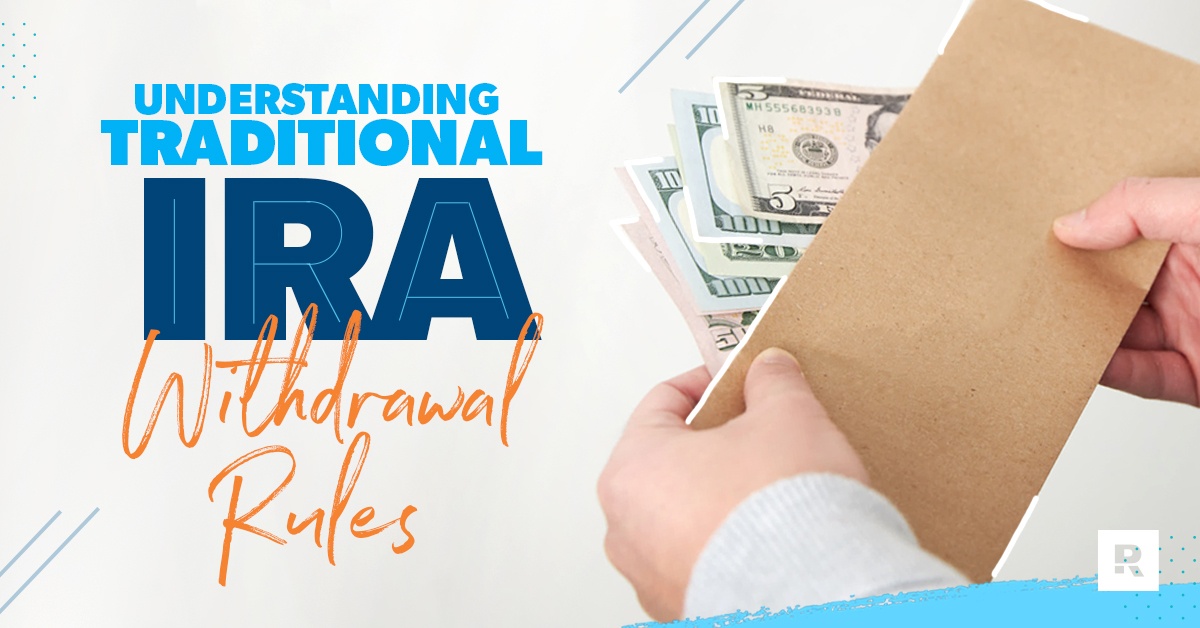What Are Traditional IRA Withdrawal Rules?
8 Min Read | Jun 5, 2025

Key Takeaways
- Traditional IRAs allow you to save money for retirement with tax-deferred contributions, but the IRS has a few rules you need to know that could impact when—and how—you take those funds out in retirement.
- If you take money out of a traditional IRA before age 59 1/2, you’ll generally pay taxes and an early withdrawal penalty—although there are some exceptions. After age 59 1/2, you’ll pay income tax at your regular tax rate for all IRA withdrawals.
- If you’re older than 70 and haven’t yet begun making withdrawals, plan to start soon—you must take Required Minimum Distributions (RMDs) by age 73.
Back in the day, it wasn’t unusual for someone to stick with one employer their entire career, working their way up the corporate ladder because there was a really nice pension plan waiting for them at retirement.
But by the late 1960s, a lot of things in American society had shifted, and people craved more flexibility in more areas of their lives—including their careers and their retirement savings. That’s a big reason why Congress created the traditional Individual Retirement Account (IRA) in 1974.
The traditional IRA is a tax-advantaged retirement plan that allows you to invest for retirement without an employer-based pension. You can also make your contributions pretax, so your money grows tax-deferred (in other words, you get a tax break now, but you’ll pay taxes when you make withdrawals in retirement). On top of all that, the traditional IRA gets you a tax deduction for every dollar you put into the account.
But of course, when Uncle Sam gives with one hand, he takes with the other—so the IRS has lots of rules about how (and when) you can take the money out of your IRA. And if you don’t follow those rules, they’ll hit you with big penalties.
Traditional IRA Withdrawal Rules
The withdrawal rules for a traditional IRA depend mostly on your age. Whether you’re 30 years old or 80 years young, you’re going to pay taxes—that’s a given. The main question here is whether you pay penalties (and extra taxes). The answer depends on whether you’re younger than 59 1/2 or older than 73 (or 75 in some cases). Let’s break it all down.
Early Withdrawals
If you’re older than 59 1/2, you can take money out of your IRA without paying an early withdrawal penalty. If you pull cash out before then, you’ll not only have to pay income taxes at your usual rate, but you’ll also have to also fork over a 10% penalty.
Pro tip: If you use your IRA as a rainy day fund, it’s going to cost you. Instead, use your 3–6 month emergency fund to help cover unplanned expenses.
In short, the IRA was designed for retirement savings, so wait until you’re retired to use it.
Required Minimum Distributions (RMDs)
If the IRS is picky about IRA withdrawals before retirement, they’re really picky about you keeping it past a certain age. To avoid a paying a big penalty, you have to begin withdrawing a minimum amount of money from your account each year. These withdrawals are called Required Minimum Distributions (RMDs).
Listen, we all know the government likes to make rules. But they especially like making extra ones that complicate your life (you’re welcome). And since Congress passed the SECURE 2.0 Act, there have been some changes to how these RMDs work.
How much will you need for retirement? Find out with this free tool!
The magical day you get to start taking RMDs—let’s call it your “RMD birthday”—depends on what year you were born. As of 2023, the RMD age is now 73. That’s great because it lets your money keep growing in your account tax-deferred for a little longer. In 2033, the RMD age is set to rise to 75.1
In other words, if you were born between 1951 and 1959, you need to begin RMDs by age 73 (if you haven’t already). If you were born in 1960 or later, you’ll begin taking RMDs at age 75.
How Required Minimum Distributions Work
If you’re required to take RMDs, you have to get it done by an IRS deadline. For the year you turn 73, you have until April 1 of the following year to take your first minimum withdrawal. Every year after that, you’re required to take out all your RMDs by December 31.
And how, exactly, does the government determine the amount of your RMD? Let’s just say the math is complicated. To be fair, the IRS does have some worksheets that can help you calculate your RMD on your own.2 Getting it wrong is what’s known in the business as a Big Deal, so if you’re still not sure, it’s probably best to check in with an investment pro to avoid any costly mistakes.
If you’re asking yourself, How bad could it really be if I get my RMDs wrong? Well, allow us to show you. Let’s pretend you didn’t take the full amount of your required minimum distribution by the deadline. Now the IRS is going to charge you a penalty of 25% on the difference between what you should have withdrawn and what you actually withdrew. And if you think that’s a little harsh, it used to be 50%!
But since we love examples, let’s say your RMD was supposed to be $10,000, but you only withdrew $2,500. The IRS will charge you a 25% penalty on that $7,500 difference, which comes out to $1,875! Yep, getting these numbers wrong could really cost you. The silver lining is, you can reduce this penalty to 10% if you correct it in a “timely manner,” meaning once they send you a notice, you have a maximum of two years to make it right. For example, if you pay your penalty by the deadline, that $1,875 would be reduced to $750.
If you’re between age 59 1/2 and your RMD birthday, you can either take withdrawals or let the money continue to grow in the account tax-deferred—it’s your choice. Just remember, you’ll pay income taxes on whatever you withdraw. If you’re not retired yet and think you’ll be in a lower tax bracket when you do retire, it’s best to let time and compound growth do their thing. Should something happen and you pass away, your account will go to your beneficiary, so no worries there.
Pro tip: You can skip the RMDs, as well as paying tax on withdrawals in retirement, by investing with a Roth IRA instead. With a Roth, you pay the taxes up front when you make your contributions. Your investments grow tax-free and you get tax-free withdrawals in retirement. That’s the biggest difference between traditional and Roth IRAs.
Exceptions to Early Withdrawal Penalties
As we've already mentioned, if you make a withdrawal before age 59 1/2, the IRS will enforce a 10% penalty on it—but there are exceptions. Here are a few real-life examples where making an early withdrawal from an IRA has no penalty:2
- If you want to change plans, you can roll the money into another IRA—but you have to get it done within 60 days of withdrawal.
- If you’re a reservist with a branch of the U.S. military and get called up for at least 180 days of active duty, you can make an early withdrawal with no penalty.
- If you adopt or give birth to a child, you can withdraw up to $5,000 to help cover expenses.
- If you’re unemployed for 12 weeks or more, you can use money from your IRA to pay for medical insurance for you, your spouse and your dependents.
- If you, your spouse, dependents or a beneficiary decide to head back to school, you can use money from your IRA to pay for qualified higher education expenses.
- If you’re a qualified first-time home buyer, you can withdraw up to $10,000 to help cover the purchase. However, you have to use the money within 120 days of taking the withdrawal.
- If you’re hit with major medical bills totaling more than 7.5% of your adjusted gross income (AGI), you can use funds from your IRA to help make those payments.
There are other exceptions (including becoming permanently disabled), and you can also avoid the penalty if you break your withdrawals into substantially equal periodic payments, known as SEPP payments.3
But here’s the bottom line: Even though the IRS does grant these exceptions, we don’t recommend withdrawing the money in your IRA for any of the above reasons. For most of these scenarios, a fully funded emergency fund should help you cover any unexpected expenses life throws your way. You’ll want to keep those dollars in your IRA working hard and earning interest to fund your retirement!
The only time you should even consider withdrawing the money from a retirement account before retirement age is to avoid bankruptcy or foreclosure. Think of the savings in your IRA as a last resort.
Get With a SmartVestor Pro
All the rules and strings attached to traditional IRA withdrawals can be frustrating, but getting access to the hard-earned money in your retirement account doesn’t have to be complicated. It’s always a good idea to sit down with an investing professional like a SmartVestor Pro to see what your options are. They can help you set goals for your financial future.
Our SmartVestor program takes the work out of finding an investment professional who can guide you in creating a retirement plan with your goals in mind.
Find a SmartVestor Pro in your area today!
Next Steps
- Explore your options with our Investing and Retirement Resources page, which features tools that can help you figure out if you’re saving enough for retirement—and much more.
- Ready to invest for retirement, but you’re not quite sure how to start? Our article How to Start Investing in 2025: A Beginner’s Guide can show you how to start investing in seven simple steps.
- Get retirement investing advice from a SmartVestor pro!
Make an Investment Plan With a Pro
SmartVestor shows you up to five investing professionals in your area for free. No commitments, no hidden fees.
This article provides general guidelines about investing topics. Your situation may be unique. To discuss a plan for your situation, connect with a SmartVestor Pro. Ramsey Solutions is a paid, non-client promoter of participating Pros.



